Muchos propietarios de sitios web no saben que pueden ejecutar varias instalaciones de WordPress en su dominio. Si desea probar nuevos diseños, crear un sitio de ensayo o iniciar un nuevo proyecto sin comprar otro dominio, una instalación de subdirectorio puede ser increíblemente útil.
Este método nos ha ahorrado incontables horas de diagnosticar problemas y ha evitado muchos desastres potenciales en sitios web. Por ello, hemos descubierto que es uno de los trucos más útiles de nuestra caja de herramientas.
¿Y lo mejor? Instalar WordPress en un subdirectorio no es tan complejo como podría parecer. En esta guía paso a paso, te mostraremos cómo instalar WordPress en un subdirectorio, tal y como hemos hecho innumerables veces para nuestros propios proyectos.
Al final de este tutorial, usted tendrá una comprensión clara de cómo crear una instalación independiente de WordPress sin interferir con su sitio principal.
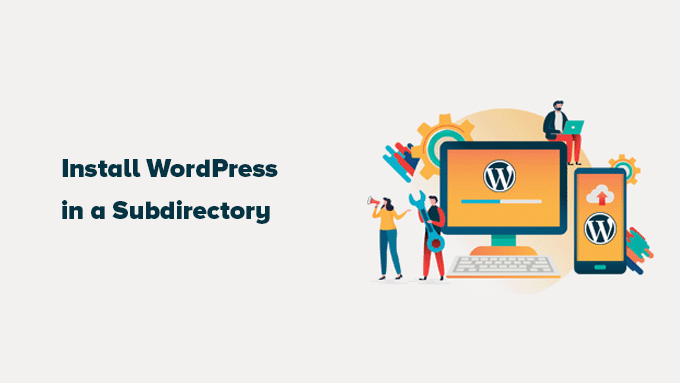
He aquí un breve resumen de lo que trataremos en esta entrada:
Subdominio vs. Subdirectorio: ¿Cuál es mejor para el SEO?
Normalmente, cuando se crea un sitio web con WordPress, se establece un nombre de dominio propio (como wpbeginner.com). Pero a veces, es posible que desee crear sitios web adicionales utilizando el mismo nombre de dominio.
Por suerte, WordPress te ofrece un par de maneras de hacerlo. Puedes instalar WordPress en un subdominio ((http://newebsite.example.com) o como subdirectorio (http://example.com/newwebsite/).
Una pregunta que nos hacen todo el tiempo es: ¿cuál es mejor para el SEO? Vamos a desglosarlo.
Los motores de búsqueda como Google tratan los subdominios como sitios web completamente separados de su dominio principal. Piénselo de esta manera: ellos ven WPBeginner y nuestro sitio WPBeginner Videos como dos entidades distintas. Esto significa que un subdominio tiene que construir su propia autoridad y poder de clasificación de forma independiente.
Por otro lado, los subdirectorios se benefician directamente de la autoridad establecida de su dominio principal. En la mayoría de los casos, esto proporciona a los subdirectorios una ventaja a la hora de posicionarse mejor en los resultados de búsqueda.
Si desea crear sitios de WordPress independientes utilizando subdominios o subdirectorios, un método popular es instalar una red multisitio de WordPress. Esto le permite gestionar varios sitios desde una única instalación de WordPress.
Sin embargo, si necesita mantener estos sitios web completamente separados y gestionados de forma independiente, también puede instalar diferentes instancias de WordPress. Para facilitar la gestión de varias instalaciones independientes de WordPress, puede utilizar herramientas de gestión de sitios de WordPress que proporcionan un único escritorio de WordPress para todos sus sitios.
Requisitos para instalar WordPress en un subdirectorio
Buenas noticias. Instalar WordPress en un subdirectorio suele ser bastante sencillo. Si ya tienes un sitio web de WordPress establecido en tu dominio principal (como tudominio.com), ya lo tienes todo listo. No necesitas hacer nada especial en cuanto al alojamiento.
Sin embargo, si tu dominio principal aloja actualmente un sitio web estático (no creado con WordPress), deberás marcar / comprobar rápidamente con tu proveedor de alojamiento web que es compatible con WordPress. La mayoría de los alojamientos de buena reputación lo hacen, pero siempre es bueno confirmarlo.
Si tu alojamiento actual no es compatible con WordPress, no te preocupes. Solo tendrás que trasladar tu sitio web a otra empresa de alojamiento.
Recomendamos Bluehost. Ofrecen un descuento fantástico en alojamiento específicamente para los usuarios de WPBeginner, e incluso incluyen un nombre de dominio gratis.
Si utiliza un proveedor de alojamiento diferente, todas las principales empresas de alojamiento de WordPress hacen que sea muy fácil instalar varios sitios web de WordPress utilizando la misma cuenta de alojamiento.
Por ejemplo, si utiliza Bluehost, puede añadir fácilmente una nueva instalación de WordPress directamente desde el escritorio de alojamiento.
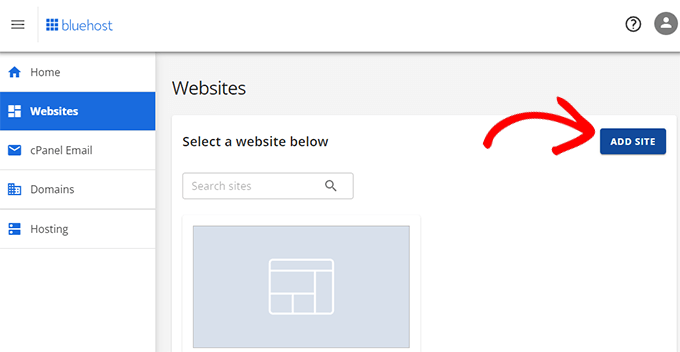
Sin embargo, recuerde que la mayoría de las cuentas de alojamiento compartido tienen recursos de servidor limitados. Si de repente uno de sus sitios web recibe mucho tráfico, podría ralentizar o afectar al rendimiento de sus otros sitios web en la misma cuenta.
Si está empezando, el alojamiento compartido suele ser perfecto. Sin embargo, a medida que su negocio y el tráfico de su sitio web crezcan, es probable que desee considerar la actualización a un alojamiento gestionado de WordPress para obtener un mejor rendimiento y escalabilidad.
Dicho esto, veamos cómo instalar WordPress en un subdirectorio fácilmente.
Paso 1: Crear un subdirectorio bajo el nombre de dominio raíz
Lo primero es lo primero, necesitas crear un nuevo subdirectorio (piensa en ello como una carpeta) bajo tu sitio web principal. Aquí es donde va a instalar todos los archivos de WordPress para su nuevo sitio
Para ello, deberá conectarse a su cuenta de alojamiento de WordPress mediante un cliente FTP, como FileZilla, o la herramienta de gestión de archivos que suele estar disponible en el panel de control de su alojamiento (como cPanel).
Una vez conectado, vaya a la carpeta raíz de su sitio web, que suele ser la carpeta /public_html/.
Si ya tienes un sitio web WordPress instalado en tu dominio principal, verás tus archivos y carpetas WordPress existentes aquí.
Lo siguiente es crear el nuevo subdirectorio. Haz clic con el botón derecho del ratón dentro de la carpeta raíz y busca opciones como “Crear nuevo directorio” o “Nueva carpeta”.
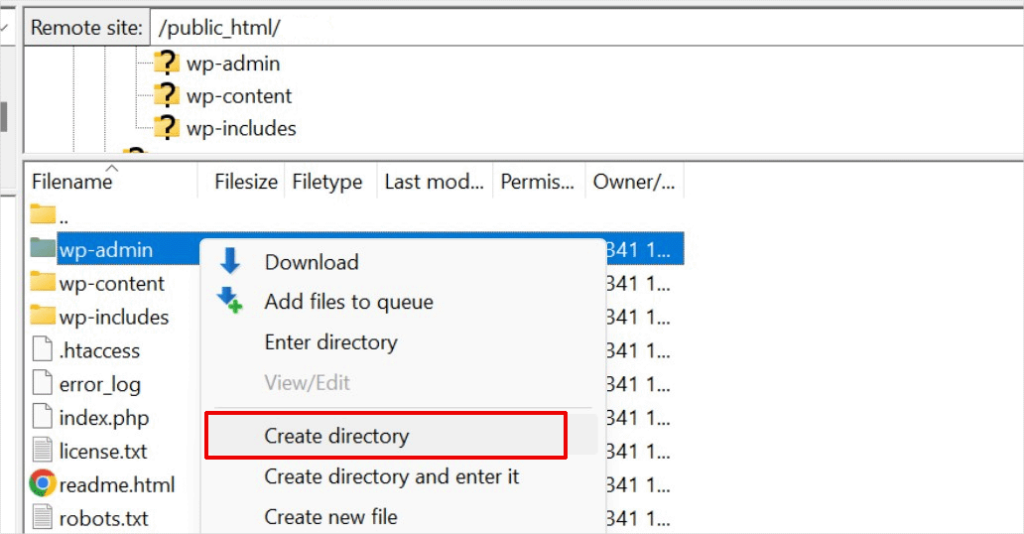
Ahora, tenga cuidado al elegir el nombre de su subdirectorio. Este nombre se convertirá en parte de la URL de su nuevo sitio WordPress, y es lo que la gente escribirá en sus navegadores para visitar este sitio web específico.
Por ejemplo, si llama a este directorio guías de viaje, la dirección de su sitio web en WordPress será: http://example.com/travel-guides/

Paso 2: Subir archivos de WordPress
Su subdirectorio recién creado está vacío en este momento. Vamos a cambiar eso subiendo archivos de WordPress.
En primer lugar, tienes que visitar el sitio web WordPress.org y hacer clic en el botón “Descargar”.
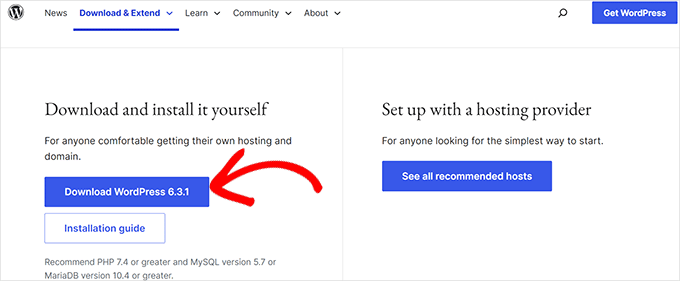
Su navegador descargará ahora en su ordenador el archivo zip que contiene el último software de WordPress.
Después de descargar el archivo, debe seleccionarlo y extraerlo:
- Usuarios de Mac: Basta con hacer doble clic en el archivo zip descargado.
- Usuarios de Windows: Haga clic con el botón derecho en el archivo zip y elija la opción “Extraer todo”.
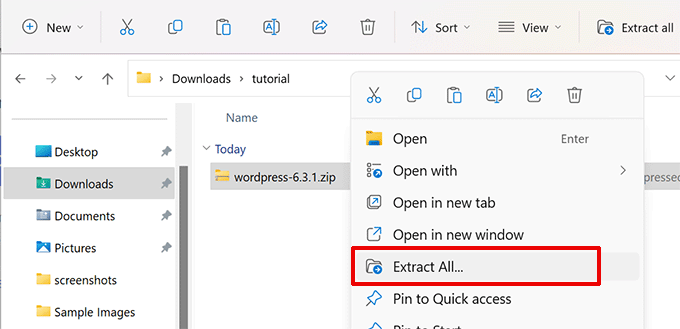
Después de extraer el archivo zip, verás una carpeta ‘wordpress’.
Dentro de la carpeta wordpress, verá todos los archivos y carpetas del núcleo de WordPress.
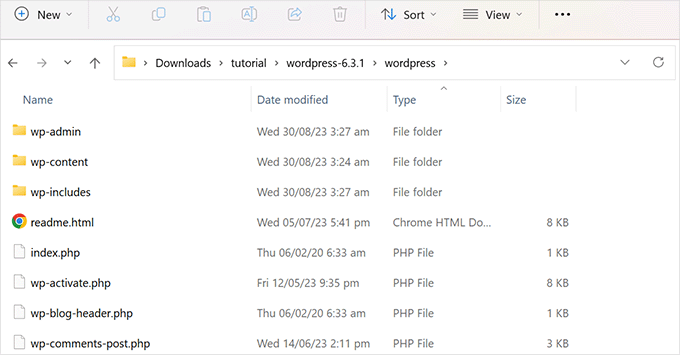
Ahora, vamos a subir estos archivos a su nuevo subdirectorio.
Conéctese a su sitio web utilizando un cliente FTP y vaya al subdirectorio que creó en el primer paso. En el panel de archivos locales de su cliente FTP, vaya a la carpeta ‘wordpress’ que acaba de extraer.
Ahora, selecciona todos los archivos dentro de la carpeta y súbelos a tu nuevo subdirectorio.
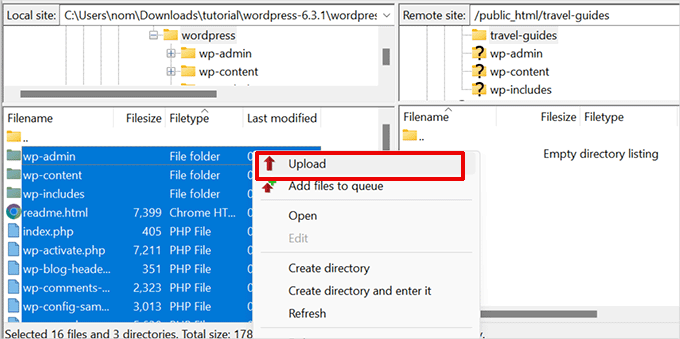
Paso 3: Crear una nueva base de datos
WordPress almacena todo su contenido en una base de datos. Dado que está instalando un nuevo sitio de WordPress en un subdirectorio, tendrá que crear una base de datos nueva para él.
En primer lugar, acceda al Escritorio de su cuenta de alojamiento de WordPress y haga clic en el botón “Ajustes” situado debajo de su sitio web.
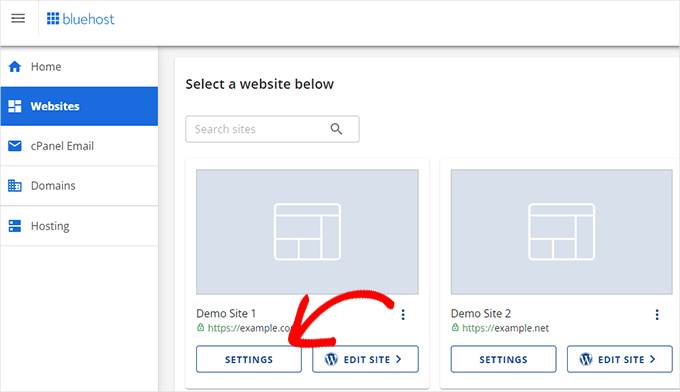
A continuación, vaya a la pestaña “Avanzado” del menú superior.
Desplácese un poco hacia abajo hasta la sección cPanel y haga clic en “Gestionar”.
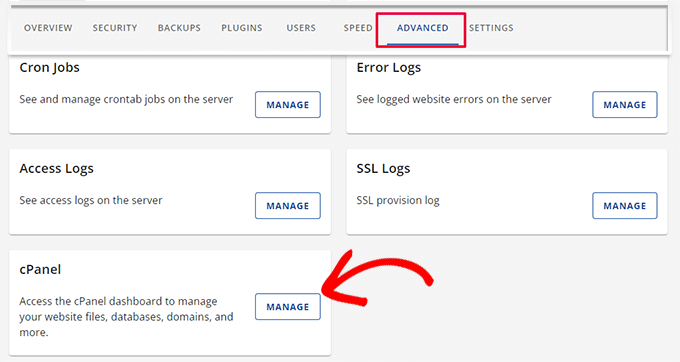
Esto iniciará el cPanel o el panel de control avanzado de alojamiento.
Desde allí, debe hacer clic en “Bases de datos MySQL” en la sección Bases de datos.
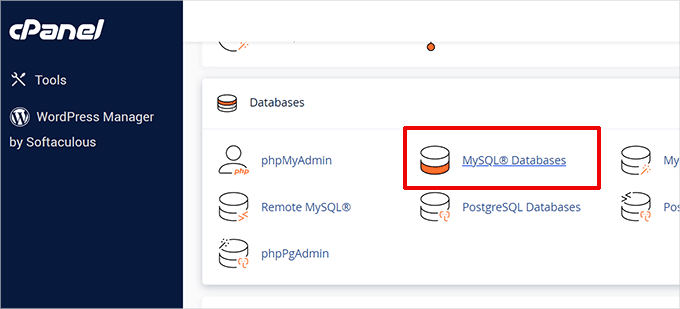
👆 El Escritorio de tu alojamiento puede parecer un poco diferente de las capturas de pantalla anteriores, pero los conceptos básicos son los mismos. Sólo tienes que encontrar el área donde se puede gestionar bases de datos.
En la pantalla siguiente, introduzca el nombre que desee para su nueva base de datos y haga clic en el botón “Crear base de datos”.
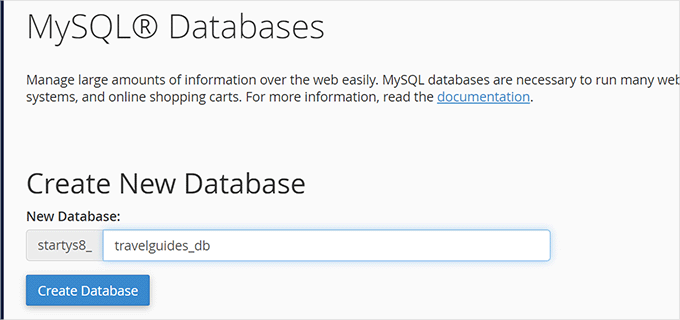
Su Escritorio de cPanel creará ahora la nueva base de datos MySQL. Una vez hecho esto, haga clic en el botón “Volver” para volver a la página Bases de datos.
Lo siguiente es crear un usuario MySQL que tenga permiso para acceder y gestionar esta nueva base de datos.
Simplemente desplázate hacia abajo hasta la sección ‘Usuarios MySQL’. Aquí podrás crear un nuevo nombre de usuario y una contraseña segura para este usuario.
Hecho esto, haga clic en el botón “Crear usuario” para continuar.
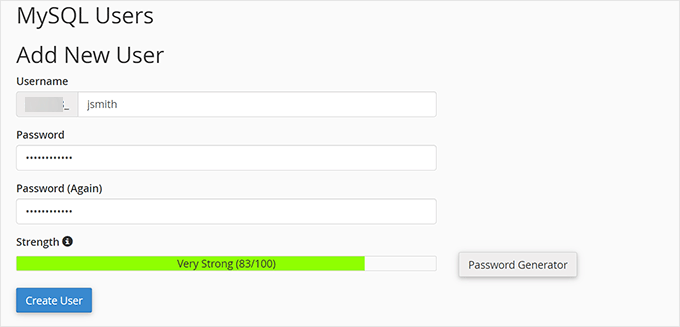
Por último, tienes que conectar este usuario a la base de datos que creaste anteriormente y darle los permisos necesarios.
Desplázate hacia abajo hasta la sección “Añadir usuario a la base de datos”. Seleccione el nombre de usuario MySQL que acaba de crear en el menú desplegable y, a continuación, seleccione el nombre de la base de datos que ha creado.
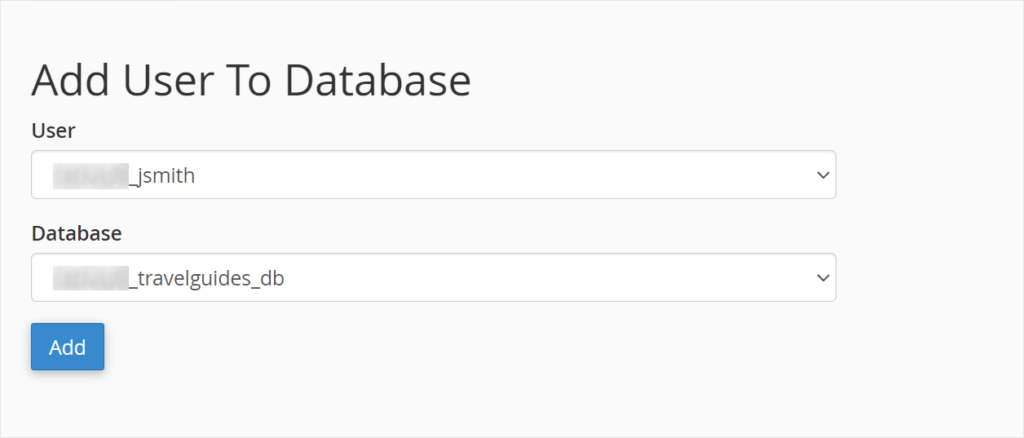
Haga clic en el botón “Añadir” para continuar.
cPanel concederá ahora al usuario MySQL privilegios completos sobre su base de datos recién creada.
Paso 4: Instalar WordPress
Ahora que todo está en su lugar, usted puede seguir adelante e instalar WordPress.
Visite el directorio que creó anteriormente en un navegador web escribiendo la URL de la siguiente manera:
http://example.com/your-subdirectory-name/
Aparecerá el asistente de instalación de WordPress. En primer lugar, seleccione el idioma de su sitio web WordPress y haga clic en el botón “Continuar”.
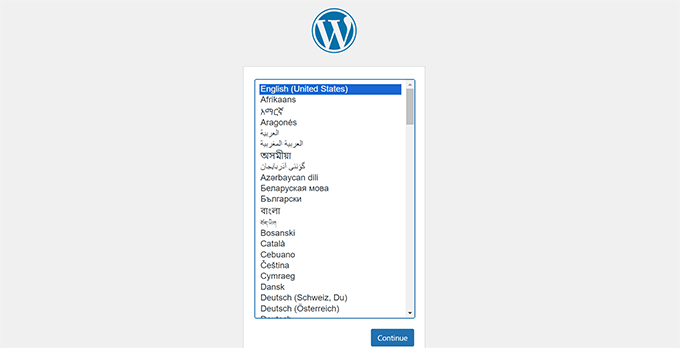
A continuación, se le pedirá que indique el nombre de su base de datos de WordPress, el nombre de usuario de la base de datos, la contraseña y el alojamiento.
Introduzca los datos de la base de datos y haga clic en el botón “Enviar”.
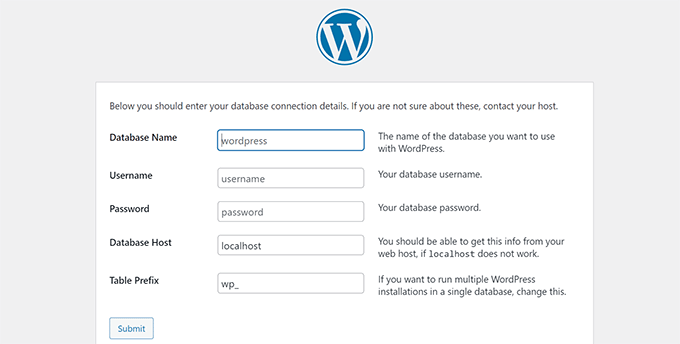
WordPress se conectará ahora a su base de datos.
Una vez establecida la conexión, aparecerá un mensaje de correcto funcionamiento como el siguiente:
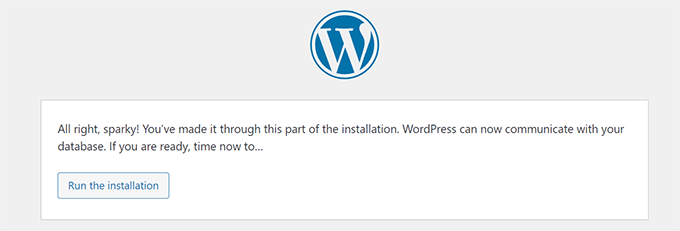
Haz clic en el botón “Ejecutar la instalación” para continuar.
En la siguiente pantalla, se le pedirá que indique un título para su sitio web y que elija un nombre de usuario de administrador, una contraseña y una dirección de correo electrónico.
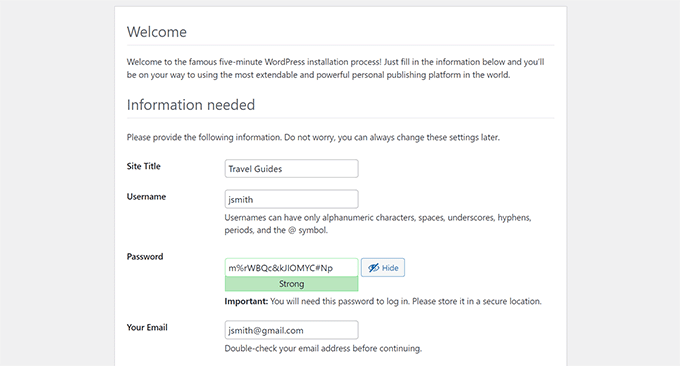
Tras introducir los datos de tu sitio web, haz clic en el botón “Ejecutar instalación” para continuar.
Ahora WordPress establecerá su sitio web y le mostrará un mensaje de correcto una vez que lo haya hecho:
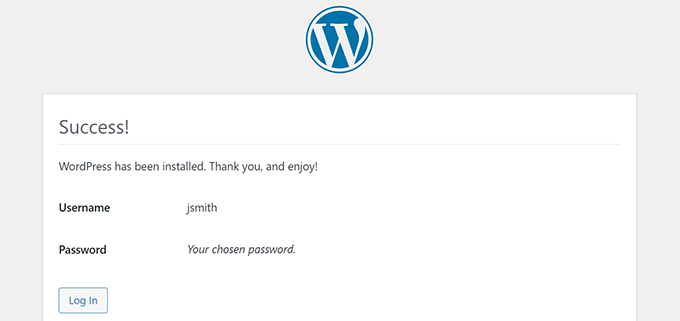
Ahora puede acceder a su nuevo sitio web WordPress, que está instalado en el subdirectorio.
Paso 5: Corrección Enlaces permanentes
Si ya tiene una instalación de WordPress separada en el directorio raíz, puede encontrarse con un problema en el que el archivo .htaccess en su subdirectorio cause un conflicto. Esto puede dar lugar a frustrantes errores 404 en tu nuevo sitio web del subdirectorio.
No te preocupes, hay una corrección sencilla. Sólo tienes que editar el archivo .htaccess en tu subdirectorio de instalación de WordPress. Reemplaza el código dentro de tu archivo .htaccess con el siguiente código:
1 2 3 4 5 6 7 8 9 10 11 | # BEGIN WordPress<IfModule mod_rewrite.c>RewriteEngine OnRewriteBase /your-subdirectory/RewriteRule ^index\.php$ - [L]RewriteCond %{REQUEST_FILENAME} !-fRewriteCond %{REQUEST_FILENAME} !-dRewriteRule . /your-subdirectory/index.php [L]</IfModule> # END WordPress |
Asegúrate de sustituir /tu-subdirectorio/ por el nombre real de tu subdirectorio.
💡 Como acabas de ver, administrar un sitio de WordPress a veces puede implicar algunos obstáculos técnicos. Si la idea de lidiar con posibles errores o actualizaciones suena estresante, entonces estamos aquí para ayudar.
Nuestros servicios de mantenimiento de WordPress eliminan las complicaciones de la gestión de sitios web, para que pueda centrarse en lo que realmente importa: ¡añadir contenido a su nuevo sitio y aumentar su audiencia!
Esperamos que este artículo te haya ayudado a instalar WordPress en un subdirectorio. A continuación, puede que desee ver nuestra guía sobre cómo hacer un sitio web de una sola página, o ver nuestra selección de expertos de los mejores editores de arrastrar y soltar página.
If you liked this article, then please subscribe to our YouTube Channel for WordPress video tutorials. You can also find us on Twitter and Facebook.





Prem Krishnan P
I have installed WordPress on the subdirectory. (i.e)www.example.com/blog) and now I created a test post (i.e.)www.example.com/blog/test. Is it possible to remove the subdirectory from the url? Looking something like this example.com/test (i.e)www. Rootsitename.com/Postname
WPBeginner Support
If you want to do that then we do not have a specific recommendation to achieve that and it would likely be best to place the post on your primary domain to achieve that.
Admin
Jiří Vaněk
This can be done using the .htaccess file, which is the Linux apache configuration file. It is possible to upload rules to this file, which can be used to rewrite URL addresses in the browser. However, it is a relatively complex topic and it is necessary to approach such an intervention sensitively.
Yevhenii Korchak
Thanks for the tutorial! Very helpful. You’re the best
WPBeginner Support
Thank you and glad to hear our tutorial was helpful!
Admin
Mangkutak
is this type of wordpress installation still can enable multisite feature if i want it to enable for my wordpress site. i heard that before long time ago that’s not possible, is that still the case today?
WPBeginner Support
You can convert a site to a multisite installation.
Admin
Mohammed
hello,
I did the same steps, once I installed WordPress and do some tests I found that cannot make save posts or publish them. an error message appears
Updating failed. The response is not a valid JSON response.
please help.
WPBeginner Support
For the invalid JSON error, we would recommend going through our article below!
https://www.wpbeginner.com/wp-tutorials/how-to-fix-the-invalid-json-error-in-wordpress-beginners-guide/
Admin
alan
Thanks for this tutorial. I wasn’t sure if I had to previously create the database or make it during the install process.
WPBeginner Support
Glad our guide was helpful!
Admin
Giwa
Hello, this steps are self explanatory but in my case, our main website doesn’t run on WordPress however we want to run WordPress on a sub-directory /blog.
How do we go about this
the main website runs on NodeJs
WPBeginner Support
You should still be able to follow the steps in this guide for what you’re wanting to do.
Admin
Abid Hasan
Today I’ve set up my new WordPress inside sub-directory. Didn’t need to change the .htaccess file. I think WP is so smart now that can handle this automatically.
WPBeginner Support
Thanks for sharing, your hosting provider may have also set it up for you when installing as certain hosts set that up for you now.
Admin
Goran
Thanks a lot for great tutorial whithout any issues.
WPBeginner Support
Glad our guide was helpful
Admin
Sam
Thank you for this guide.
We are planning to have subdirectories on our next website. This guide really cleared the air.
One question though,
Is there a limited to how many subdirectories a WordPress website can have?
WPBeginner Support
There is not a hard limit to the number of directories at the moment.
Admin
Swetha
Hi.. thanks for this article… am unable to upload the folders wp-admin, wp-content and wp-includes in the sub directory… rest other files are uploaded.. how do I upload all of these???
WPBeginner Support
It would depend on why you are unable, if you reach out to your hosting provider they should be able to assist but it may be a permissions issue with your user.
Admin
Arinze
Thanks it worked.
Is it possible to the subdirectory name on the URL, for example example.com/seo/how-to-rank to example.com/how-to-rank
WPBeginner Support
If you would like your URLs not to have the subdirectory in the URL we would recommend installing the site on your primary domain rather than creating redirects to remove it from the URL.
Admin
Arinze
Thanks for this article. It is very insightful.
Will the installation of WordPress on the sub folder affect the overall speed of the site.
WPBeginner Support
It should not
Admin
dennis wille
there is an apparent error in your htaccess code example
should be
# BEGIN WordPress
RewriteEngine On
RewriteBase /your-subdirectory/
RewriteRule ^index\.php$ – [L]
RewriteCond %{REQUEST_FILENAME} !-f
RewriteCond %{REQUEST_FILENAME} !-d
RewriteRule . /your-subdirectory/index.php [L]
# END WordPress
note rewriterule line 5 change
WPBeginner Support
Thank you for catching that, while not specifically required, we’ll look to update the article
Admin
Deddy Hidayat
I want to build a web with a wordpress subdirectory, the first web is domain.com, and the second web is domain.com/blog … as far as I know wordpress uses domain.com/blog as the default post … will it hurt SEO?
WPBeginner Support
WordPress does not use /blog as a default, that is only the most common URL to use. Using blog for a subdirectory should not have a major effect on SEO.
Admin
Shashank Dubbewar
is it necessary to install and manage same plugins separately if I installed wordpress on main domain and sub directory each and manage wordpress sites separately ?
WPBeginner Support
If it is on a different site even on a subdirectory, the plugins are managed for each individual site. You could also take a look at some recommended tools for managing multiple sites in our article below:
https://www.wpbeginner.com/showcase/how-to-easily-manage-multiple-wordpress-sites/
Admin
Mohd Kaleem
Hello Sir, Can I create Subdirectory without login Cpanel. I forgot My Hosting Details. But I have WP details, is it possible to create subdirectory using wordpress any plugin or other way?
WPBeginner Support
You would need access to your hosting, you should be able to reach out to your hosting provider for assistance in being able to log back into your account.
Admin
Kosi
Thank you. This worked! Really grateful….
WPBeginner Support
You’re welcome, glad our guide was helpful
Admin
Nicoleiver
Hi, I would like to ask is it possible to copy all the file from my current folder to the sub directory? Because I want to have the same template and plugin for my sub directory site.
WPBeginner Support
For a starting point, you could take a look at our guide on how to make a staging site below and instead of installing the site on staging you could have all of your content on the subdomain of your choice and modify the content to be that of your new site. You can find our guide on setting up a staging site below:
https://www.wpbeginner.com/wp-tutorials/how-to-create-staging-environment-for-a-wordpress-site
Admin
John Doe
What if the I created a new subdirectory from another subdirectory, should the fix permalink still be relevant and work with no problem?
For example, I have firstwebsite.com/firstsubdir/ the second subdirectory will be firstwebsite.com/firstsubdir/secsubdir/ should I still use the same fix for the permalink?
Sorry English is not my first language.
WPBeginner Support
You would need to include the second subdirectory in the permalink change and it should still work.
Admin
keram
Thanks for a clear tutorial.
Is it possible to install WP in a subdirectory but use the main domain URL to access it and still have the main URL displayed in the browser address bar?
To clarify:
I would install WP in mydomain.com/sub/ but would like to access it by opening mydomain.com and have mydomain.com displayed in the browser so that visitors can bookmark my URL.
Is it possible to set it up?
WPBeginner Support
It is possible but would depend on your hosting provider to see if it is allowed. If you reach out to your hosting provider they should be able to assist.
Admin
keram
Will the pages load faster if WP is installed in the subdirectory?
WPBeginner Support
Where your site is installed on your host shouldn’t affect your site’s loading time to a noticeable degree
Ghulam Mujtaba
Salam, I just finished reading the article and i have question, how can i have the same header and footer from the wordpress installation in parent directory? I’ll be glad and thankful to you if you give me a clue, Thanks…
WPBeginner Support
For that, the simplest method would be to install the same theme on both sites.
Admin
Priscilla
Hello,
Thans for this awsome tuto, it works!
WPBeginner Support
Glad our guide was helpful
Admin
Sohail
Really helpful! One question please.
Do I have to add this line:
RewriteBase /your-subdirectory/
for every install in a sub directory in main WordPress installation?
Thanks
WPBeginner Support
Yes, we would recommend this to prevent any issues on the subdirectory
Admin
Samantha
Thank you for this information! Helped me a lot!
WPBeginner Support
You’re welcome, glad our guide could help
Admin
Alex
Hi. I manually copied my WordPress files to the root folder, without the plugin. I then copied the original database in a new one, where I replaced the siteurl to reflect the new location, the root folder. In the wp-config file at the root folder, I changed WP_HOME and WP_SITEURL to remove the /wordpress.
As a result, I was able to reach the wp-login for my new location, but no further.
And when I visited my site, I was getting a warning “too many redirections”.
Any advice?
WPBeginner Support
There are a few possible reasons, for a starting point, you would want to go through the steps in our article here: https://www.wpbeginner.com/wp-tutorials/how-to-fix-error-too-many-redirects-issue-in-wordpress/
Admin
Abhishek mahajan
Thanks a lot for WP subfolders step by step guide. One thing that i never undersatnd is how to create a exact Google news xml sitemap in WordPress?
WPBeginner Support
Most SEO plugins should add the required markup for you to be able to be added to Google News. If you are using an SEO plugin you would want to reach out to the plugin’s support for what they recommend for setttings.
Admin
Hesam
Thanks for your article. I have a question about transforming this sub domain or sub directory installed word press to main root of website and replace it with the main site. what should I do?
WPBeginner Support
It would depend on what you mean, you could take a look at our guide here: https://www.wpbeginner.com/wp-tutorials/how-to-get-rid-of-wordpress-from-your-wordpress-site-url/
Admin
Umesh Yellaboina
Hi Team, Thanks for this post, not only these… all the other posts in your blog are very helpful to us, I really appreciate your works. Thanks a lot for these.
And need a little help, actually did the same as in this post, installed wordpress in a sub directory, but I’m face a little issue, i.e. I’m unable to receive the emails from contact form, when it was on sub-domain it’s working fine, but when it is installed on sub-directory not receiving the form submissions, it’s going on loading but not getting submitted. Please help me with this. Thank you.
WPBeginner Support
If they’re not being stored in your site if they should when submitted you would want to reach out to your form plugin’s support. If you are not receiving an email then you would likely want to use SMTP: https://www.wpbeginner.com/plugins/how-to-send-email-in-wordpress-using-the-gmail-smtp-server/
Admin
David
Thanks for the info. I read every post you write.
Just I’ve a doubt. I created a new WP Install trough my Host provider, but searching, there is no .htaccess file in the subdirectory. It’s mandatory to have a new .htaccess file? it’s going to create errors in the future?
WPBeginner Support
WordPress should generate the htaccess file if you resave your permalinks. If you still don’t see it you may not have the option to show hidden files enabled
Admin
Rubens
thankkkkkkkssssssss <3
WPBeginner Support
You’re welcome
Admin
Eulises Quintero
Hello, I successfully installed WordPress in a subdirectory around 3 weeks ago, I already uploaded a theme, some plugins and made some posts. Question, can I change the name of my subdirectory? How? the name is Chose for my subdirectory and what shows after my original website URL is español, I want to make it es, I want to change this because I read somewhere that characters like ñ might cause some issues in terms of SEO….so now I’m worried, thank you for your time
WPBeginner Support
If the site has been set up for some time, you would want to follow the steps in our article here: https://www.wpbeginner.com/wp-tutorials/how-to-properly-move-wordpress-to-a-new-domain-without-losing-seo/
If you recently installed it on the subdomain then you wouldn’t need to notify Google
Admin
Mosiur Rahman
Hey, I just followed the process except i haven’t changed the htaccess file. My site is still working properly. I am using hostinger.
is changing the htaccess mandatory ? will it cause error in the future?
WPBeginner Support
Your host may have set up the redirect for you, if you reach out to your host they should be able to let you know.
Admin
Owaiz Yusufi
Just got it to work but little bit worried, does it increases my load time of both pages. I mean to say that
( currently I have made this on localhost for test but I am going to implement it in one or two days on my main server )
I have two website but single domain
Just want to know that does this will increase the bandwidth useage and load time.
Let’s suppose if I my main webpage size 1 mb and my second website size is also 1 mb so when someone load the main page does it loads all the 1+1 2mb size.
WPBeginner Support
Hi Owaiz,
Yes it will increase bandwidth usage depending on your traffic. Since both WordPress installs share the resources, traffic load on one website will affect the performance of other website as well.
Admin
billybob
Wow, worked first time! Thank you so much!!
maxime
Thank you very much, clear and working
Mauwiks
My site got a white screen of death after this.
Shankar
Really Its very useful for beginners to install
Karen
Hello, I dont understand something. What is the difference between installing wordpress in a subdirectory and just creating multiple pages???
I am a noob
Simson
I think I did everything as shown in your instructions. But the trouble I’m having is when I’m trying to customize my theme on the subdirectory it taking me to the root domain wp customizer. What should I do then… ?
Yoki andika
Hello, can you help me?
I installed my local wordpress to the subdir with ftp but the problem is the css doesn’t work properly, and i don’t know what’s wrong with my wordpress, because i follow this step.
Maybe Anyone can help?
Thank you
Kandra
Hi,
I am following the steps that you have recommended in creating the sub directory, but than I see the following error,
When I trying to open the URL after uploading all the files to the folder through FTP,
I see the URL redirecting to wp-admin/setup-config.php & throwing an server error 500 (This page isn’t working
simplyrent.in is currently unable to handle this request.
HTTP ERROR 500)
Jyotishman Nath
I have heard that subdirectories are treated as part of root domain in terms of ranking.But my subdirectory is not ranking, even for exact match keyword search.I have indexed Subdirectory using Fetch as Google Tool.I don’t know what is the problem?
I have submitted it to Search Console, Created separate robot.txt and sitemap (Sitemap is pending from last two days).
Should I give more time to Google to Crawl by Subdirectory?
Please Replay.
Thanks!
WPBeginner Support
Hi Jyotishman,
It is up to search engines to decide how they would rank your website in their results. All you can do is optimize your website for SEO and follow the best practices.
Admin
Layon
Thank you for this tutorial. It saved me after hours trying to understand why I was getting 404 errors all day long.
Johnny
just put this in your .htaccess
DirectoryIndex index.php
thank me later!
TH
Question: Login for main and subdirectory
Hi. I created a subdirectory with a separate WP install.
It looks like the user has to create an account for the main and subdirectory and to login for both the main and subdirectory.
Is there a way to let a user who has login to either the main or subdirectory site to have access to the other site without having to login again? i.e if user has login into main site, he/she does not need to login to the subdirectory site. and vice versa.
Thanks.
TH
Dragos
By default, if you are using softaculous, you are installing wordpress to the default directory named wp. You don’t need to install manually WordPress in a directory/ subdomain, you only need to change the name of the directory where you want Softaculous to install WordPress and it will also make a database and so on.
medmouncef
Thanks for this tutorial.
It would be interesting to show, when you have a little time of course, how to configure cPanel redirects to this subdirectory. For example, I can’t redirect my domain name to a WordPress subdirectory créé sous /public-html.